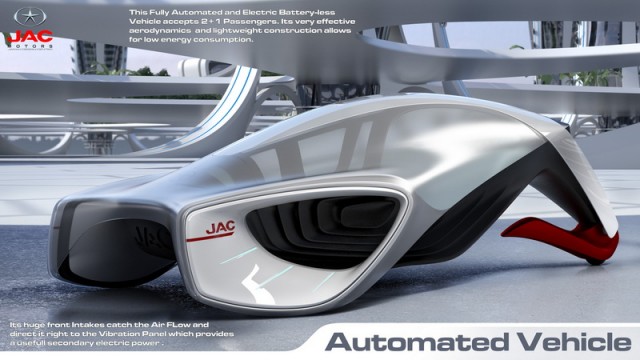JAC Motors R&D Center in Japan entered the 2013 LA Design Challenge with its HEFEI (Harmonious Eco-Friendly Efficient Infrastructure). As the name suggests, it's rather more than just a car, and gives JAC's vision of the vehicle of 2025 that gives back as much as it takes out of the environment. Though wouldn't that be perpetual motion? Exterior:
It's hard to even call this a vehicle, never mind a car. The concept doesn't appear to have any conventional wheels as such. It makes contact with the ground at only three points, twice at the front and once at the rear, which is where a generator is housed. Overall the vehicle is comprised of one large 'polylactic' panel that opens up to allow passenger entry and exit. Two large air intakes at the front also house the tracks that each front wheel rides on.
Exterior
The main reason that the JAC Motors Vehicle looks like a high-heel shoe is that, when its passengers disembark after a journey to its central hub, the vehicle is then pulled up along the outside of the building along a track where it locks in place at the rear wheel, which normally provides stability when driving, extends out and acts like a propeller in order to generate electricity as a wind turbine.
Interior
As the vehicle is fully automated the interior is designed to be a relaxing environment where passengers can simply chill out or conduct business or social media updates while getting from A to B. It's also a slightly cosy affair as there is just one large 2+1 seat, which is made from biopolymer memory foam and affords passengers the ability to enjoy a particularly reclined seating position. The seat also uses materials that convert body heat into secondary electrical power.
Mechanicals
In order to be as eco-friendly as possible, virtually all of the materials used come from recycled sources or naturally occurring ingredients. For example the intake would be constructed from 'Polyhydroxyalkanoates' which (if you didn't already know) come from bacterial fermentation of sugar. Main power for the vehicle comes from an on-board electrical power unit that has a 'Witricity' receiver, which acts like a long-distance form of conductive charging - meaning it doesn't even have to be in direct physical contact with the recharger in order to top up its power.
Anything else?
The HEFEI was created as part of the 2013 edition of the annual LA Design Challenge, which runs alongside the LA Auto Show. Automotive design studios from around the world are invited to participate and this year, studios from Germany, Japan and the US competed to design "Biomimicry & Mobility 2025: Nature's Answer to Human Challenges."

